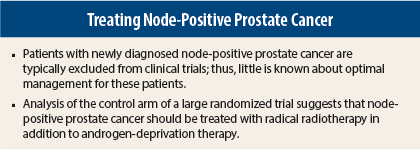Node-positive prostate cancer has typically been excluded from clinical trials, leaving oncologists with little evidence to guide management for this group of patients. A study presented at the European Society for Medical Oncology (ESMO) 2014 Congress sheds light on this issue, providing the strongest evidence to date that radical radiotherapy (to the pelvis and lymph nodes) added to androgen-deprivation therapy improves survival in node-positive patients.1
The evidence comes from a post hoc analysis of the control arm of the phase III STAMPEDE trial, which showed that the addition of radiation to androgen-deprivation therapy prolonged failure-free survival, an endpoint that included biochemical failure, disease progression, or death, in men with high-risk prostate cancer, including both node-negative and node-positive cancers.
Radiation plus androgen-deprivation therapy is already considered standard of care for high-risk node-negative patients, and these new data support similar management of node-positive patients.
STAMPEDE Details
“The STAMPEDE trial supports the use of radical radiotherapy in both node-positive and node-negative patients and argues against the use of androgen-deprivation therapy alone for node-positive disease,” stated Chris Parker, MD, Consultant in Clinical Oncology at the Royal Marsden Hospital, London.
The analysis focused on a cohort of 721 men from the control arm of STAMPEDE. All men initiated treatment with androgen-deprivation therapy. Radiotherapy was optional at study initiation, but after two large trials established the role of radical radiotherapy added to androgen-deprivation therapy in node-negative disease, radiation to the prostate (with or without radiation to the pelvis and lymph nodes) was planned for node-negative patients in the control arm of STAMPEDE. At baseline, median prostate-specific antigen level was 43 ng/mL, 40% (n = 287) were node-positive on imaging (not histology), and median Gleason score was 8 to 10.
Median failure-free survival was 63 months for all 721 patients in the control arm. Radiation was planned in 121 node-negative men and not planned in 59. Among node-negative men who got radiation, the 3-year failure-free survival rate was 84%, compared with 62% in those who did not. The adjusted risk reduction in favor of radiation was 74%.
“These results coincide precisely with those from the completed randomized trials and are encouraging when we move to node-positive patients where we don’t have such data from randomized trials,” Dr. Parker continued.
In node-positive patients, radiation was planned for 98 men and not planned for 80 men. The 3-year failure-free survival rate was 71% for men who got radiation vs 47% for those who did not, representing a 49% reduction in risk of progression or death.
“This analysis is based on intention to give radiation when enrolling in STAMPEDE. It is possible that patients slated for radiation did not get it, and it is also possible that some patients for whom radiation was not intended at enrollment, subsequently received it,” he added.
Landmark Analysis
A landmark analysis was conducted to account for these possibilities and showed even more impressive results than the original analysis; the adjusted hazard ratio in node-positive men was 0.35, representing a 65% reduction in risk of progression or death. In node-negative patients, risk of progression or death was reduced by 74%.
“Results were remarkably similar for men with node-positive and node-negative disease. Depending on which analysis you go by, the addition of radiation to [androgen-deprivation therapy] reduced the risk of [failure-free survival] by 49% or 65% in node-positive men,” he said.
“One limitation of this analysis is that the groups were small,” Dr. Parker said. “However, we have no better-quality data on node-positive men anywhere else, so we should use these data to guide clinical management,” he stated. ■
Disclosure: The study authors reported no potential conflicts of interest.
Reference
1. James N, Spears M, Clarke N, et al: Impact of node status and radiotherapy on failure free survival in men with newly diagnosed non-metastatic prostate cancer: Data from >690 patients in the control arm of the STAMPEDE trial. ESMO 2014 Congress. Abstract 754O. Presented September 28, 2014.



